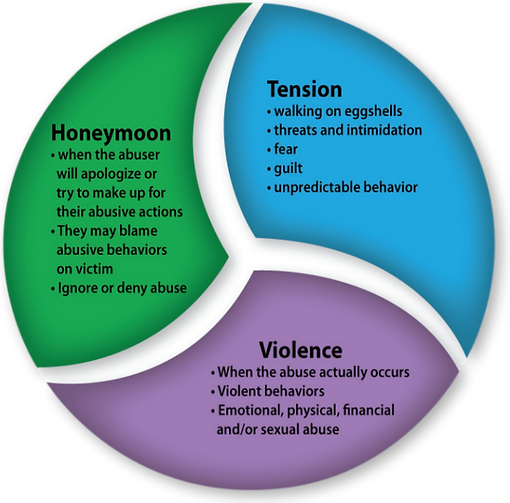
Fight Against
Domestic Violence
Fight Against
Domestic Violence

Clear Creek Advocates
WHAT IS DOMESTIC VIOLENCE?
WHAT IS DOMESTIC VIOLENCE?
Domestic violence is a crime.
“An act or threatened act of violence against a person with whom the actor is or has been involved in an intimate relationship.” Domestic Violence also includes “any other crime against a person or against property, or any municipal ordinance violation against a person or against property when used as a method of coercion, control, punishment, intimidation or revenge directed against a person with whom the actor is or has been involved in an intimate relationship.”
Domestic violence occurs in a cycle.
Battering is an intentional act used to gain power and control over the other person.
The precipitating factor is usually some event unrelated to the victim’s behavior.
The State of Colorado has a domestic violence law mandating physical arrest and formal charges for those who commit domestic violence.
The Cycle of Violence
The Cycle of Violence
Stage I – Tension Building
Stage I – Tension Building
Tension exists between the family members. It is displayed by the batterer becoming increasingly irritable, jealous, or threatening.
Stage II – Explosion
Stage II – Explosion
The battering incident. The tension becomes unbearable and is uncontrollably discharged.
Stage III – The Honeymoon
Stage III – The Honeymoon
The batterer is extremely loving and apologetic. Gifts are often given along with promises that the abuse will never happen again.
Then it begins again.

Personality Characteristics in Domestic Violence
Personality Characteristics in Domestic Violence
Characteristics of People Who Choose Abusive Behaviors
Characteristics of People Who Choose Abusive Behaviors
- Found in all socioeconomic, educational, ethnic, racial, and age groups.
- Uses psychological, verbal, and physical abuse, including sexual abuse.
- Emotionally dependent, subject to secret depression known only to family, low self-esteem, insatiable ego, overwhelming need to be right.
- Belief that forcible behavior is aimed at securing the family nucleus.
- General history of abuse.
- Believes victim is personal property or possession, is to blame for problems, is crazy or out of control, victim deserves abuse.
- Limited tolerance for frustration, demonstrates anger but often masks it, explosive temper.
- Alcohol or drugs are often involved.
Characteristics of the Survivor
Characteristics of the Survivor
- Found in all socioeconomic, educational, ethnic, racial, and age groups.
- Is psychologically, verbally, and physically abused, and uses sex to establish intimacy.
- Emotionally and economically dependent, subject to depression, home accidents, low self-esteem, and is unsure of own needs.
- Belief that transient acceptance of violent behavior will ultimately lead to a long-term resolution of family problems.
- Generational history of witnessing abuse in family and/or being used.
- Complaint, helpless, powerless, and accepts all blame.
- At high risk for secret use of alcohol and drugs.
- Frequently wishes partner were dead and frequently contemplates suicide.
There are five leading factors causing death in a domestic violence situation. If all questions below have a “yes” answer, the victim is in real danger of being killed when or shortly after a violent dispute erupts.
- Has the suspect ever choked you or put their hands around your neck, threatening to choke you?
- Have children been present during this or other incidents of domestic abuse?
- Has the suspect ever threatened to hurt or kill you? Have they ever threatened to hurt or kill other family members? Have they ever threatened to hurt or kill themselves?
- Has the suspect ever violated a “No Contact” order or other court orders regarding custody or probation?
- Does the suspect have access to weapons? Have they ever used a weapon to threaten or hurt you?

